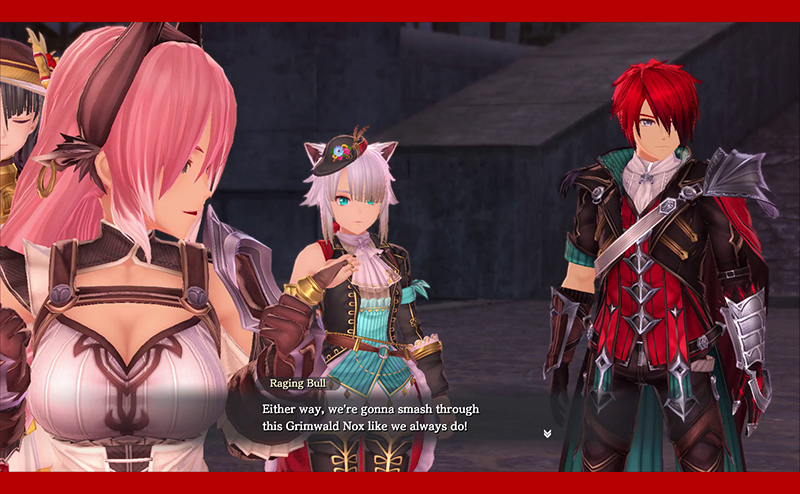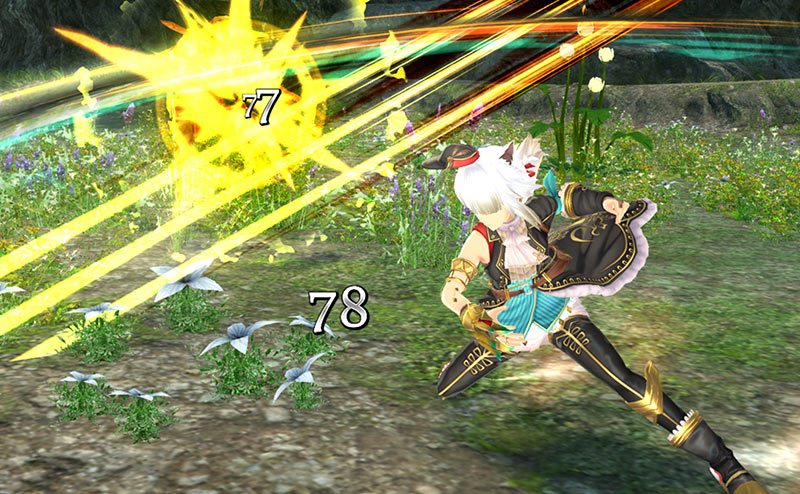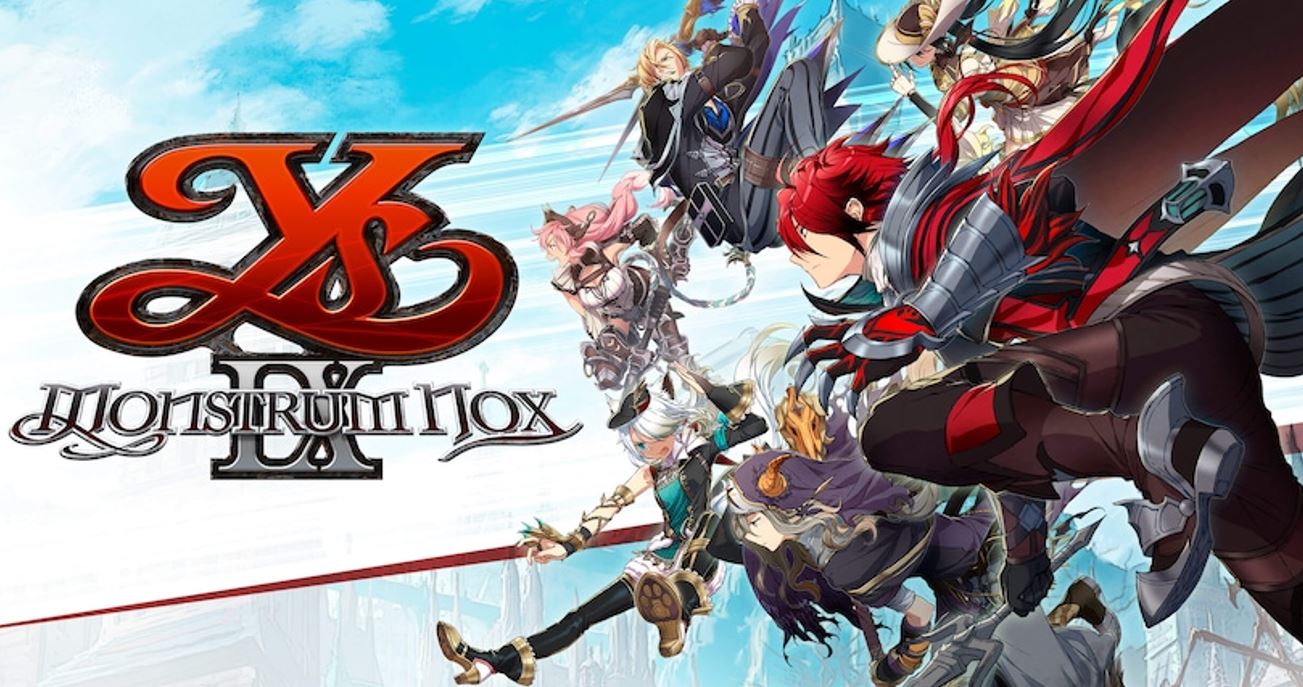Mario and Zelda are two of my favorite game series of all time. I’ve looked forward to every major release since I was a kid in the 80s and 90s. Despite only finding the series in 2017, my love for Nihon Falcom’s Ys matches the Nintendo powerhouse series. I enjoy the retro classics with their bump combat system, the mid-2000s era push forward action, and the current party system seen in Ys VIII: Lacrimosa of Dana. They all combine frenetic action, fun adventure stories and engaging characters to pure
Ys IX: Monstrum Nox eschews the stereotypical Adol shipwreck opening. Our crimson haired hero is immediately arrested upon entering Balduq city. While escaping, Adol is locked into a fight against an ancient evil threatening Balduq. To combat this new foe, he’s given supernatural powers and joins a team of similarly powered people called the Monstrums. From there the adventure takes us throughout Balduq city, it’s massive prison and surrounding countryside.
Story
Ys IX’s plot is filled with fun twists and turns. Mysteries lay around every corner of Balduq. Who and what are the Monstrums? Why is the city under threat from an ancient evil force? What is happening in the Prison? These are the major story threads that slowly weave a satisfying little plot. It’s hardly mind blowing storytelling, but by the final cutscene all the mysteries were satisfactorily wrapped up.
More than the plot, it’s the characters you meet along the journey that flesh out the story. None are particularly original, but the archetypes are well done. Hawk is the perfect example. An angry young loner always looking for a fight. Hawk lashes out at authority and see’s relying on others as weak. No surprise, by the games end his dark past is revealed and he learns to embrace the strange family of Monstrums he’s been thrust into. Cliché as he may be, Hawk avoids becoming an annoying stereotype by being just likeable enough.
Of the main playable party, White Cat is easily my favorite. Adopted daughter to a successful merchant, she learns the value of being her own person rather than doing what others expect of her. Early chapters spend lots of time building her relationship with Adol. It’s implied she harbors feelings for him, but it never becomes a full romantic arc. They’re friends, comrades and equals; something I very much appreciate in a JRPG. She also holds up in gameplay, with her Special Attacks doing massive damage and her wall run opening up exploration opportunities.
Outside the playable party, the most intriguing character is the Monstrum’s lead, Aprilis. Early in the storyline she shoots Adol with a strange gun that transforms him into a superpowered Monstrum. A move that traps him in Balduq and should place her firmly in the villain role. Yet it’s apparent throughout the story her actions are done from a place of caring. Sitting firmly in a grey area is a difficult balance to maintain, but she manages it for most of the game. In the end she swings firmly into one end of the hero-villain spectrum. I won’t reveal which side she falls on, but I enjoyed every appearance she made.

Unfortunately, the side characters supporting Adol and the Monstrums are less engaging than those found in Ys VIII. Iris, an assassin you’ll meet in Balduq prison, is especially grating with her petulant attitude. The English voice acting for Iris is over the top annoying. Chante is another disappointment, never becoming more than a gay stereotype. I’d love to see a gay character with depth in a JRPG, but I haven’t found one yet. If they’re out there, leave a comment. I want to play that game.
As for the translation, NISA have done a fine job here. I noticed a spelling mistake here and there, some minor grammatical errors too. In a script as large as this I’m not surprised some minor issues crept in. Nothing impacted my enjoyment of the game. Overall the dialogue and descriptive text are solid translations.
Gameplay
The gameplay follows the template began in Ys Seven and perfected in Lacrimosa of Dana. You begin as Adol, and chapter by chapter add new player characters to your team. By the final chapter you have six playable characters, each fitting into one of three build types: slash, strike and pierce. Each build is useful against particular enemy types, creating a strong incentive to switch between characters. Each PC has special skills that can be leveled up through use, creating more gameplay variety.
Despite the system allowing for variety, combat doesn’t feel different as you switch between characters. Outside the slash, strike and pierce difference they feel similar in movement and attack abilities. This isn’t helped by the characters sharing their unique abilities. Adol can teleport to set points throughout levels, White Cat runs up walls, Hawk can glide, etc. As you add a new party member, the others can use that special ability. It streamlines gameplay, but removes character uniqueness.

Thankfully my complaint is minor, as the overall combat system is fast and fun. There’s a flow to Ys combat that I absolutely love. Regular attacks transition smoothly into Skill attacks, never interrupting the fight’s pace. You’re almost always pushing forward. Even dodging an attack moves you forward, as a perfectly timed dodge increases your speed and makes you momentarily invulnerable. Flash Guard blocks an attack and turns your strikes into critical hits for more damage. This provides a nice risk/reward element to combat.
In my review of Ys VIII, I complained about bosses being damage sponges causing battles to become boring. Thankfully this isn’t the case in Ys IX. Bosses patterns are interesting to learn, but don’t grow stale through endless repetition. This applies to the returning Raid battles too. They tie directly into the ongoing narrative and impact the finale. They’re engaging, challenging, but never feel like a slog. I looked forward to each Grimwald Nox, something I cannot say about Ys VIII’s raids.
Combat is only half the fun of an Ys game. Exploration is equally important. Much of the game see’s Adol trapped in Balduq city, with dungeons being part of the city itself. Eventually the map opens into land surrounding the city, providing much needed variety. Balduq is interesting enough to explore that I never bored retreading ground. Despite this, Ys 9 falls short of the epic feeling I had discovering each new location in Ys 8’s Isle of Seiren. I miss the sense of wonder Seiren evoked.
On the other hand, moving around Balduq is a total blast. Adol’s teleporting is speedy, WhiteCat’s wall run adds verticality and Hawk’s glide covers large distances. Movement is vitally important to fun gameplay, and Falcom nailed it here. I hope these abilities return for the inevitable Ys X. If the next game can use them to explore a more engaging environment we could have the best Ys game yet.
Aesthetics
My play through was on a base model PS4, which has gameplay maxed at 30fps. Performance dipped here and there while exploring the larger areas of the game. Thankfully it ever crashed, only a frame rate stutter here and there. None of my issues hurt the overall experience. Unless you’re a 60fps purist, Ys IX runs okay, but its worth noting if you have an older PS4.

The performance issues are no surprise as its running off the same ancient engine that powered the series PSP entries in the 2000s. Balduq City might lack an epic scope, but it’s technically a more complex setting. Rendering it must take far more effort than the open areas of a tropical island. Overall, the Falcom engine is showing it’s age. There’s nothing impressive about the graphical quality.
Colorful anime style character and monster designs help compensate for the older graphics engine. In fact, character design is one element Ys IX easily trumps the previous game for. While I’ll always adore Dana, the Monstrums superhero-like designs are incredible. Adol as the Crimson King has a gothic darkness to him, but the bright red really pops as he zips across the screen.
Even more impressive than the artistic design is the game’s soundtrack. Falcom never disappoints when it comes to music. Invitation to the Crimson Night and Tranquil Silence are haunting melodies that remind me of Castlevania: Symphony of the Night, and there’s no higher praise for a game OST. On the other end of the spectrum is the intense battle theme for Cloaca Maxima. While this isn’t Falcom’s best soundtrack, there isn’t a single track worth criticizing. From start to finish the music always compliments the game’s mood.
Conclusion
Ys IX: Monstrum Nox is a solid action JRPG. It very much follows the path laid out by Ys VIII. There’s some improvements like character movements around the world, but also weaker elements like the plot and characters compared to the previous game. If you’ve never played an Ys game, I wouldn’t recommend Monstrum Nox as the place to start. Lacrimosa of Dana and Oath in Felghana both stand above this entry, but if you enjoyed Ys VIII and want to experience more from the series, pick this title up. You will be glad you did.
Summary
Pros
Movement is fast, fluid and fun
Bosses are challenging, but quick
Charming main characters
Cons
Performance & graphic issues
Dull side characters
Doesn’t exceed the high of Ys VIII

